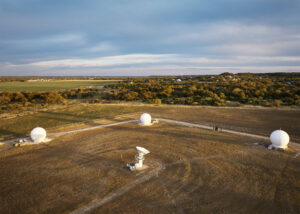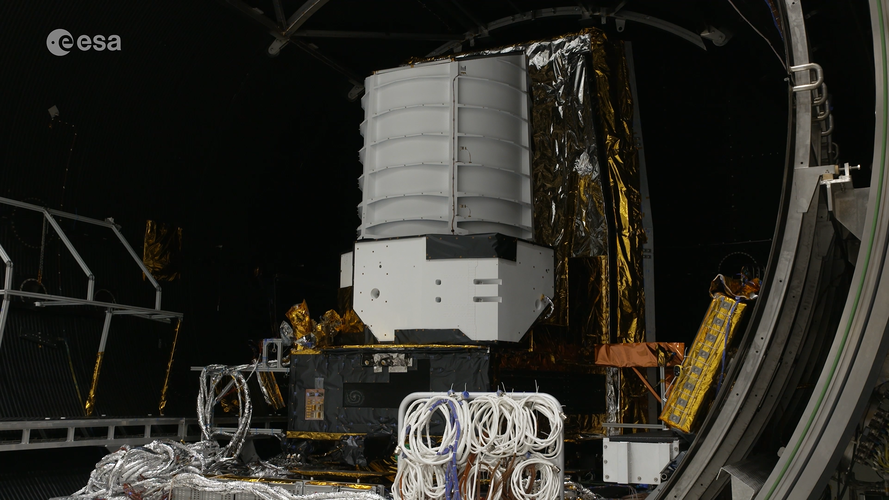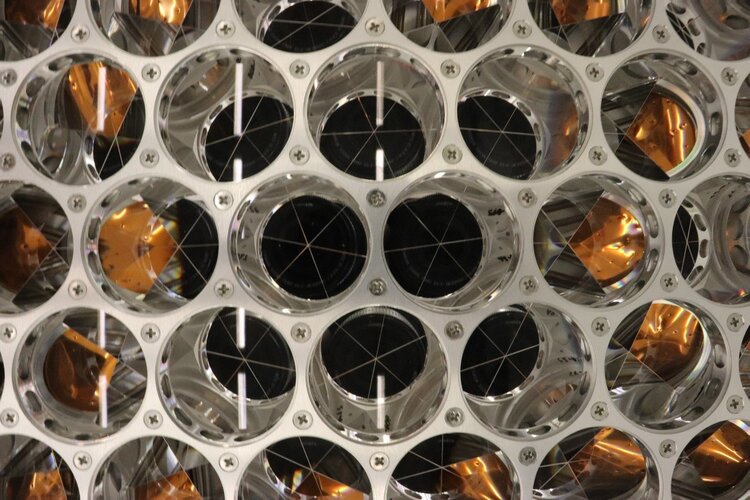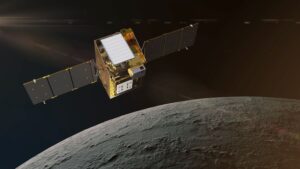Advanced Space wins $72 million Air Force contract for lunar experiment
Thursday, 10 November 2022 21:41
The Air Force Research Laboratory awarded a $72 million contract to Advanced Space to develop an experimental spacecraft to monitor deep space, far beyond Earth’s orbit.
The post Advanced Space wins $72 million Air Force contract for lunar experiment appeared first on SpaceNews.
Space Development Agency still hoping to launch satellites next month, ‘but there’s risk’
Thursday, 10 November 2022 20:59
The Space Development Agency remains optimistic it will launch next month the first satellites of a planned mesh network of sensors and communications nodes in low Earth orbit
The post Space Development Agency still hoping to launch satellites next month, ‘but there’s risk’ appeared first on SpaceNews.
Apple lays the groundwork for emergency SOS via satellite service
Thursday, 10 November 2022 20:19
Apple said Nov. 10 its $450 million investment in an SOS via satellite service has helped Globalstar upgrade ground stations across the United States and elsewhere with high-power antennas.
The post Apple lays the groundwork for emergency SOS via satellite service appeared first on SpaceNews.
Section of destroyed shuttle Challenger found on ocean floor
Thursday, 10 November 2022 18:21
Cosmic radiation detection takes front seat during NASA's Artemis I space mission
Thursday, 10 November 2022 16:35
Although bad weather and technical issues forced NASA to postpone its August and September launch attempts for Artemis I—an uncrewed space mission that will voyage around the moon and back—the space agency is looking towards a launch window in the second half of November 2022, possibly November 16. The highly anticipated space flight will be the first to test the new Orion spacecraft along with its rocket and ground systems.
The Artemis I mission is the first step in NASA's plans to carry human crews to further explore the lunar surface and eventually establish a sustainable outpost on the moon. The flight would also contribute to the groundwork required for a mission to Mars. When it blasts off from the Kennedy Space Center in Florida, Artemis I will carry two mannequins strapped into its crew module.
Antenna developer NXT Comm’s assets up for sale
Thursday, 10 November 2022 15:06
Satellite antenna developer NXT Communications Corp.’s equipment, property, and other collateral are being auctioned off amid production delays that have left L3Harris Technologies in the lurch.
The post Antenna developer NXT Comm’s assets up for sale appeared first on SpaceNews.
Video: What is ESA's Moonlight initiative?
Thursday, 10 November 2022 15:06
Going to the moon was the first step. Staying there is the next ambition.
ESA is a key partner in NASA's Artemis program, which aims to return people to the moon by the end of the decade. Dozens of other international public and private missions are setting their sights on the lunar surface in the coming years.
But to achieve a permanent and sustainable presence on the moon, reliable and autonomous lunar communications and navigation services are required.
This is why ESA is working with its industrial partners on the Moonlight initiative, to become the first off-planet commercial telecoms and satellite navigation provider.
Following their launch, three or four satellites will be carried into lunar orbit by a space tug and deployed one by one, to form a constellation of lunar satellites. The number and specification of these satellites are currently being defined.
The constellation's orbits are optimized to give coverage to the lunar south pole, whose sustained sunlight and polar ice make it the focus of upcoming missions.
Euclid completes thermal vacuum testing
Thursday, 10 November 2022 15:00 Video:
00:05:17
Video:
00:05:17
At the Thales Alenia Space test facility in Cannes, France, the massive door of the thermal vacuum chamber was opened after a month of rigorous testing of ESA’s Euclid mission to explore the dark Universe. In Cannes the fully integrated spacecraft was subjected to the conditions of space and its subsystems were fully tested for the first time. With the Euclid space telescope, scientists hope to learn more about dark matter and dark energy which could make up more than 95% of our Universe.
The film includes soundbites from ESA Euclid Mission and Payload Manager: Alexander Short and
US weather satellite, test payload launched into space
Thursday, 10 November 2022 13:16
A satellite intended to improve weather forecasting and an experimental inflatable heat shield to protect spacecraft entering atmospheres were launched into space from California on Thursday.
A United Launch Alliance Atlas V rocket carrying the Joint Polar Satellite System-2 satellite and the NASA test payload lifted off at 1:49 a.m. from Vandenberg Space Force Base, northwest of Los Angeles.
Developed for the National Oceanic and Atmospheric Administration, JPSS-2 was placed into an orbit that circles the Earth from pole to pole, joining previously launched satellites in a system designed to improve weather forecasting and climate monitoring.
The NASA mission blog said there was no immediate data confirming deployment of the solar array that will power the satellite. "There may not be an issue, but we're monitoring closely as more telemetry data becomes available," the post said.
The array has five panels that were collapsed in an accordion fold for launch. The fully deployed array would extend 30 feet (9.1 meters).
Mission officials say the satellite represents the latest technology and will increase precision of observations of the atmosphere, oceans and land.
After releasing the satellite, the rocket's upper stage reignited to position the test payload for re-entry into Earth's atmosphere and descent into the Pacific Ocean.
NASA laser reflector for ESA satnav on Lunar Pathfinder
Thursday, 10 November 2022 12:32
NASA has delivered a retroreflector array to ESA that will allow the Lunar Pathfinder mission to be pinpointed by laser ranging stations back on Earth as it orbits the Moon. Such centimetre level laser measurements will serve as an independent check on the spacecraft as it fixes its position using Galleo and GPS signals from an unprecedented 400 000 km away from Earth – proving the concept of lunar satnav while also relaying telecommunications ahead of ESA’s dedicated Moonlight initiative.
NASA to continue Lunar Trailblazer despite cost overrun
Thursday, 10 November 2022 12:08
NASA will continue a lunar smallsat mission for launch in mid-2023 despite exceeding its cost cap by 30%.
The post NASA to continue Lunar Trailblazer despite cost overrun appeared first on SpaceNews.
MDA selects Rocket Lab to supply satellite operations control center for the Globalstar constellation
Thursday, 10 November 2022 11:35 Rocket Lab USA, Inc (Nasdaq: RKLB) has been selected by MDA Ltd (TSX: MDA) to develop the Satellite Operations Control Center (SOCC) for Globalstar's (NYSE American: GSAT) growing constellation. MDA is the prime contractor for Globalstar's new Low Earth Orbit constellation.
The SOCC contract builds on the existing relationship between MDA, Rocket Lab, and Globalstar established in February
Rocket Lab USA, Inc (Nasdaq: RKLB) has been selected by MDA Ltd (TSX: MDA) to develop the Satellite Operations Control Center (SOCC) for Globalstar's (NYSE American: GSAT) growing constellation. MDA is the prime contractor for Globalstar's new Low Earth Orbit constellation.
The SOCC contract builds on the existing relationship between MDA, Rocket Lab, and Globalstar established in February Astra laying off 16% of workforce, honing focus on development
Thursday, 10 November 2022 11:35 California-based rocket company Astra will lay off 16% of its workforce, it announced with its quarterly financial report Tuesday.
The company reported a net loss of $199.1 million in the third quarter, including $133 million in impairment charges, and an adjusted EBITDA loss of $41.4 million. Its revenue was $2.8 million.
Reducing the workforce will help Astra save funds, a port
California-based rocket company Astra will lay off 16% of its workforce, it announced with its quarterly financial report Tuesday.
The company reported a net loss of $199.1 million in the third quarter, including $133 million in impairment charges, and an adjusted EBITDA loss of $41.4 million. Its revenue was $2.8 million.
Reducing the workforce will help Astra save funds, a port MAVEN observes Martian light show caused by major solar storm
Thursday, 10 November 2022 11:35 For the first time in its eight years orbiting Mars, NASA's MAVEN mission witnessed two different types of ultraviolet aurorae simultaneously, the result of solar storms that began on Aug. 27.
MAVEN - the Mars Atmosphere and Volatile Evolution mission - is the only asset at Mars able to observe the Sun's activity and the response of the thin Martian atmosphere at the same time. Real-time a
For the first time in its eight years orbiting Mars, NASA's MAVEN mission witnessed two different types of ultraviolet aurorae simultaneously, the result of solar storms that began on Aug. 27.
MAVEN - the Mars Atmosphere and Volatile Evolution mission - is the only asset at Mars able to observe the Sun's activity and the response of the thin Martian atmosphere at the same time. Real-time a Perseverance activities at Amalik outcrop
Thursday, 10 November 2022 11:35 On Sol 579 (October 6, 2022), Perseverance collected a sedimentary sample named "Mageik," the mission's 14th rock core, from the Amalik outcrop in the Enchanted Lake region at the base of the Jezero delta. Following collection of the Mageik sample, the rover processed a "witness tube."
The witness tubes do not collect samples but are opened near the sampling location to "witness" the marti
On Sol 579 (October 6, 2022), Perseverance collected a sedimentary sample named "Mageik," the mission's 14th rock core, from the Amalik outcrop in the Enchanted Lake region at the base of the Jezero delta. Following collection of the Mageik sample, the rover processed a "witness tube."
The witness tubes do not collect samples but are opened near the sampling location to "witness" the marti 
